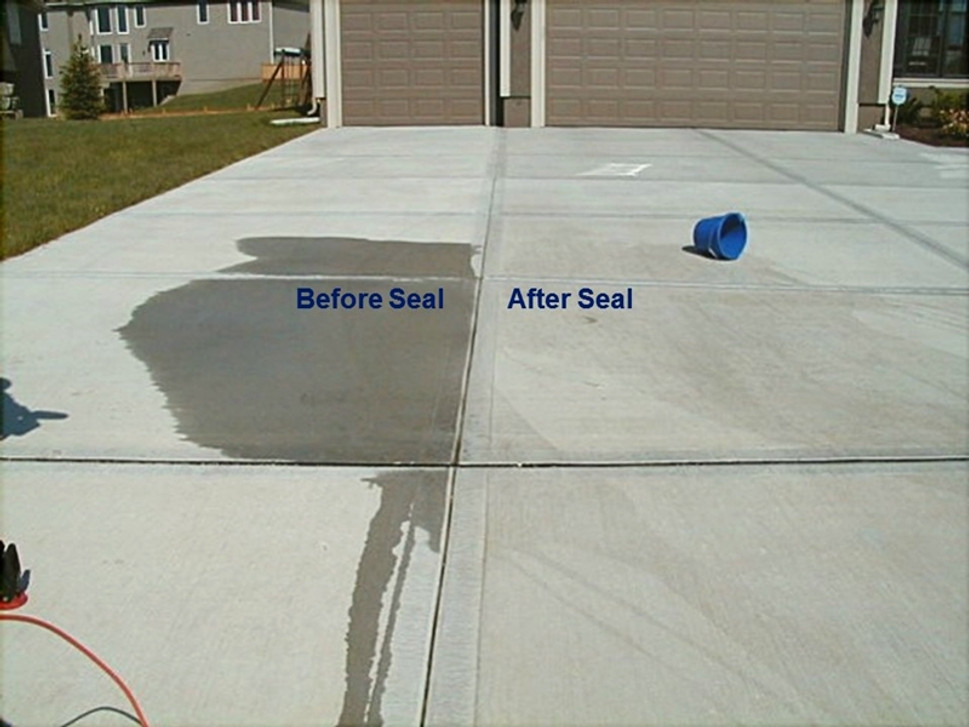Why seal your concrete? A frequent question in our industry is "Why seal my concrete?" Extensive scientific research by concrete authorities (American Concrete Institute, Portland Cement Association, Nation Ready-Mix Concrete Association and others) confirm that much of the damage to concrete is caused by moisture intrusion into the concrete in the form of freeze-thaw damage which causes cracking, pitting, spalling (the top layer separating from the concrete) and other damage.
That all sounds very scientific but what it means is that water gets inside your concrete, freezes (and when water freezes it expands up to 10% in size) and breaks the internal cell walls, causing internal damage to your concrete. The water then melts and can refreeze causing even more damage. And if the water gets to lignite or shale that is in the rock used when the concrete is mixed, these substances can absorb a lot of water and when they freeze, they can push the top layer of your concrete off creating pits or holes in the surface of the concrete. If your concrete was poorly finished and there are layers in the concrete, water can get between these layers, freezing and causing the layer to peel off of the surface. This is called spalling. The goal then is keep water out of your concrete.
In very hot areas, it is important to seal your concrete to keep the water in the soil under your concrete from being pulled through by evaporation bringing the salts and minerals inside the concrete to the surface causing white dust on the surface. Not only is this unsightly but it is destroying your concrete internally by removing the minerals necessary to keep it solid.
What are concrete sealers? Concrete sealers are substances applied to concrete to protect it from water intrusion, surface damage, corrosion, and staining. There are two major types of concrete sealers – Topical Sealers (i.e. coatings, surface sealers or film-formers) which create a barrier to stop chemicals, stains and water intrusion and Penetrating Sealers which close or block the pores via a chemical reaction which reduces water and stain absorption into the concrete. Topical Sealers provide a gloss or the “wet look” to visually enhance the concrete as well as to provide protection against intrusion of water, salts, stains, and chemicals. Because they are on the surface, they need to be reapplied on a regular basis. Penetrating Sealers do not modify the natural look or feel of the concrete as the active process is inside the concrete. They also last longer than topical sealers and are semi-permanent.
How to pick a sealer- Out of all the hundreds of concrete sealers available in the market – how do you determine the correct sealer for your personal concrete project?
1) Determine the type and use of the surface you wish to seal and to protect. Is it concrete, clay brick, cinder block, concrete pavers, natural stones, decorative concrete, stamped concrete, epoxy stones, exposed aggregate, etc.?
2) Is it a trowel finish (smooth) or broom finish (has little lines in it – most outdoor concrete is broom finish)?
3) Is it above grade, on-grade or below ground level?
4) Is it indoors or outdoors? If it is outdoors, is it in the shade or does it get full sun?
5) How much use will the surface get? For example will your children be rollerblading on your basement floor or will it be used to watch TV? Will food be served? Do you use your patio and/or pool deck every day or only occasionally? Higher usage areas will require different types of sealers.
6) How porous is the surface? More porous surfaces may need more coats of sealer or a special type of sealer.
7) Has the surface been sealed previously or does it have anything on it such as carpet glue, black mastic, paint, that needs to be removed before sealing? To determine if your surface has been sealed previously, you can test by pouring water over the surface. If the concrete does not change color immediately, it has been sealed and this sealer needs to be removed before applying any new sealer.
8) Define the final look that you are expecting to see after sealer application. Do you want a matte, satin, gloss or high gloss finish? Sealers, like paint, come in different gloss levels. Higher gloss levels become slippery when wet and you may have to use an anti-skid product which will diminish the gloss.
9) Determine how often you want to do maintenance on your concrete surfaces. Higher usage and the higher gloss levels provided by Topical Sealers require higher amounts of maintenance. Surface sealers require more maintenance than a true penetrating sealer.
10) To test that a sealer has been correctly installed, pour water over the sealed surface 24 hours after the application. If the concrete does not change color immediately, the sealer is working. If the concrete changes color immediately the sealer is not working correctly. Water beading on the surface of the concrete is an old method to determine if the concrete was sealed or not. Color change is what the construction industry uses today. Not all sealers bead water on the surface.
When you have answered all of the above questions, you are prepared to talk to a sealer manufacturer who can then assist you in picking the correct sealer for your surface and your project.

